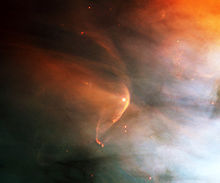Properties and structure

Fast and slow solar windedit
The solar wind is observed to exist in two fundamental states, termed the slow solar wind and the fast solar wind, though their differences extend well beyond their speeds. In near-Earth space, the slow solar wind is observed to have a velocity of 300–500 km/s, a temperature of ~100 MK and a composition that is a close match to the corona. By contrast, the fast solar wind has a typical velocity of 750 km/s, a temperature of 800 MK and it nearly matches the composition of the Sun's photosphere. The slow solar wind is twice as dense and more variable in nature than the fast solar wind.
The slow solar wind appears to originate from a region around the Sun's equatorial belt that is known as the "streamer belt", where coronal streamers are produced by magnetic flux open to the heliosphere draping over closed magnetic loops. The exact coronal structures involved in slow solar wind formation and the method by which the material is released is still under debate. Observations of the Sun between 1996 and 2001 showed that emission of the slow solar wind occurred at latitudes up to 30–35° during the solar minimum (the period of lowest solar activity), then expanded toward the poles as the solar cycle approached maximum. At solar maximum, the poles were also emitting a slow solar wind.
The fast solar wind originates from coronal holes, which are funnel-like regions of open field lines in the Sun's magnetic field. Such open lines are particularly prevalent around the Sun's magnetic poles. The plasma source is small magnetic fields created by convection cells in the solar atmosphere. These fields confine the plasma and transport it into the narrow necks of the coronal funnels, which are located only 20,000 km above the photosphere. The plasma is released into the funnel when these magnetic field lines reconnect.
Pressureedit
The wind exerts a pressure at 1 AU typically in the range of 1–6 nPa ((1–6)×10−9 N/m2), although it can readily vary outside that range.
The ram pressure is a function of wind speed and density. The formula is
where mp is the proton mass, pressure P is in nPa (nanopascals), n is the density in particles/cm3 and V is the speed in km/s of the solar wind.
Coronal mass ejectionedit
Both the fast and slow solar wind can be interrupted by large, fast-moving bursts of plasma called coronal mass ejections, or CMEs. CMEs are caused by release of magnetic energy at the Sun. CMEs are often called "solar storms" or "space storms" in the popular media. They are sometimes, but not always, associated with solar flares, which are another manifestation of magnetic energy release at the Sun. CMEs cause shock waves in the thin plasma of the heliosphere, launching electromagnetic waves and accelerating particles (mostly protons and electrons) to form showers of ionizing radiation that precede the CME.
When a CME impacts the Earth's magnetosphere, it temporarily deforms the Earth's magnetic field, changing the direction of compass needles and inducing large electrical ground currents in Earth itself; this is called a geomagnetic storm and it is a global phenomenon. CME impacts can induce magnetic reconnection in Earth's magnetotail (the midnight side of the magnetosphere); this launches protons and electrons downward toward Earth's atmosphere, where they form the aurora.
CMEs are not the only cause of space weather. Different patches on the Sun are known to give rise to slightly different speeds and densities of wind depending on local conditions. In isolation, each of these different wind streams would form a spiral with a slightly different angle, with fast-moving streams moving out more directly and slow-moving streams wrapping more around the Sun. Fast moving streams tend to overtake slower streams that originate westward of them on the Sun, forming turbulent co-rotating interaction regions that give rise to wave motions and accelerated particles, and that affect Earth's magnetosphere in the same way as, but more gently than, CMEs.

Comments
Post a Comment